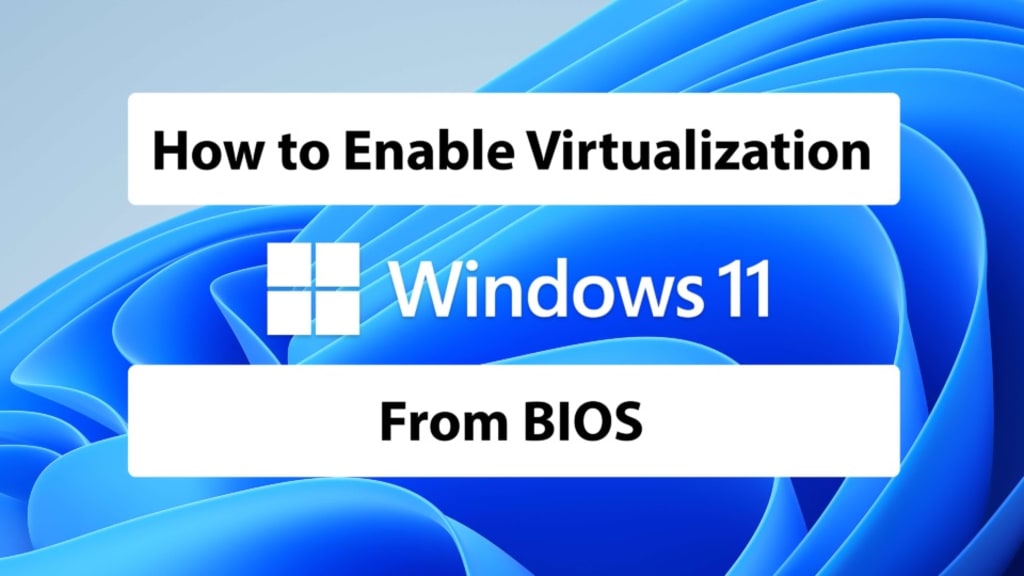How Do I Turn On Virtualization in Windows 11? Simple Instructions
How to Enable Virtualization in Windows 11? Easy Guide

In this article, we will learn how to Enable Virtualization in Windows 11. The most current machines can enable virtualization in Windows 11 in BIOS to share resources more efficiently between several physical and virtual machines. Thanks to virtualization, we can abstract the hardware from our computer to allocate it to a workload that can share these resources between the physical and virtual operating systems.
Introduction
Virtualization is a powerful technology that allows you to run multiple operating systems on a single physical computer. It's particularly useful for developers, IT professionals, and anyone who needs to test different software configurations or run virtual machines for various purposes. In Windows 11, turning on virtualization is a straightforward process, and in this article, we'll provide you with simple instructions to enable virtualization on your Windows 11 PC.
What is Virtualization?
Virtualization is the process of creating a virtual or simulated version of something, such as an operating system, server, storage device, or network resource. In the context of personal computing, virtualization enables you to run multiple virtual machines (VMs) on a single physical computer. Each VM can run its own operating system and applications, providing isolation and flexibility for various tasks.
Why Enable Virtualization in Windows 11?
Enabling virtualization in Windows 11 is crucial for running virtual machines, such as those created with software like VMware Workstation, VirtualBox, or Hyper-V. Virtualization is also required to take advantage of certain Windows 11 features, such as Windows Subsystem for Linux 2 (WSL 2) and Hyper-V. Whether you're a developer needing multiple development environments or a user who wants to run different operating systems on the same machine, virtualization is an essential tool.
Here's how you can turn on virtualization in Windows 11:
Step 1: Check Your Hardware
Before enabling virtualization, ensure that your computer's hardware supports virtualization technology. Most modern PCs and laptops do, but it's better to confirm this to avoid any issues. To check for virtualization support, follow these steps:
Restart your computer.
While it's booting up, access your computer's BIOS or UEFI settings. This usually involves pressing a specific key during startup, such as F2, F10, or Del. The exact key may vary depending on your computer's manufacturer.
Look for an option related to virtualization technology. It might be named "Virtualization Technology," "Intel Virtualization Technology (VT-x)," or "AMD Virtualization (AMD-V)." Enable this option if it's disabled.
Save your changes and exit the BIOS or UEFI settings.
Step 2: Enable Hyper-V (Optional)
If you plan to use Microsoft's Hyper-V virtualization platform, you can enable it through Windows Features. Here's how:
Press the Windows key and type "Turn Windows features on or off." Press Enter to open the Windows Features window.
Scroll down and locate "Hyper-V." Check the box next to it.
Click "OK" to confirm and enable Hyper-V. Your computer will restart to apply the changes.
Step 3: Enable Virtualization in Windows Security
To ensure virtualization is fully enabled in Windows 11, you can use Windows Security. Here's how:
Press the Windows key and type "Windows Security." Press Enter to open the Windows Security app.
In Windows Security, click on "Device security" in the left sidebar.
Under the "Core isolation" section, click on "Core isolation details."
Make sure "Memory integrity" is turned off. This may interfere with virtualization.
Step 4: Restart Your Computer
After completing the above steps, restart your computer to apply the changes fully.
Conclusion
Enabling virtualization in Windows 11 is essential for running virtual machines and taking advantage of various software and features. By following these simple instructions, you can ensure that your Windows 11 PC is ready to host virtual environments, allowing you to expand your computing capabilities and meet various computing needs. Whether you're a developer, IT professional, or simply a curious user, virtualization in Windows 11 opens up a world of possibilities.





Comments (1)
Windows 11 is a great system. I can recommend this system, especially since the price in this store is really low: https://royalcdkeys.com/products/call-of-duty-modern-warfare-2-2022-cross-gen-edition-us-ps4-5-cd-key